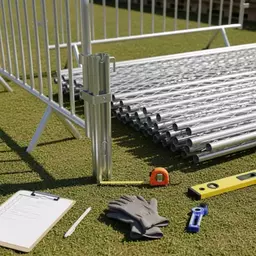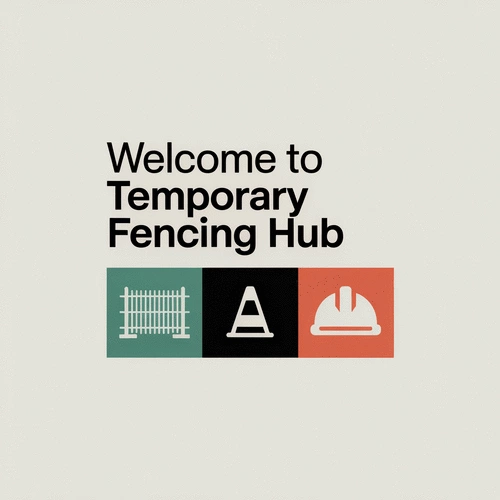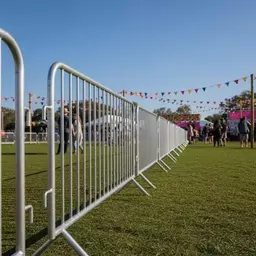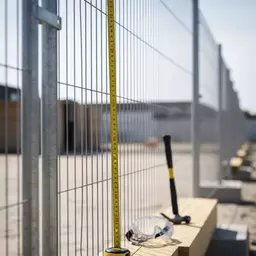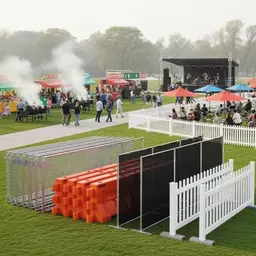In an era where safety and efficiency are paramount, understanding temporary fencing can be a game-changer. With diverse applications across various industries, knowing the ins and outs of this essential tool ensures you're always prepared.
What You Will Learn
- Temporary fencing provides a flexible and sturdy barrier suitable for various applications, including construction sites and events.
- Customization options for temporary fencing include height, length, and design, allowing adaptations to different environments and safety needs.
- Understanding local regulations is crucial to ensure compliance and avoid potential fines when using temporary fencing.
- Key types of temporary fencing include mesh, chain-link, panel fencing, and crowd control barriers, each serving distinct purposes.
- Cost factors to consider when renting or purchasing temporary fencing include type, duration, location, and additional charges for delivery and installation.
- Making informed decisions about temporary fencing enhances safety, compliance, and the overall reputation of your project or event.
Common Uses and Types of Temporary Fencing in Australia
This visual highlights the diverse applications and primary types of temporary fencing, crucial for safety and compliance in various Australian settings.
Common Uses in Australia
Event Management
Construction Sites
Emergency Situations
Animal Control
Key Types of Temporary Fencing
Mesh Fencing
Chain-Link Fencing
Panel Fencing
Crowd Control Barriers
Understanding Temporary Fencing and Its Purpose in Australia
Welcome to the world of temporary fencing! As someone who has been immersed in this industry for over a decade, I can tell you that understanding the basics is crucial for anyone in need of fencing solutions. Temporary fencing serves as a critical element in protecting people, property, and projects across Australia. Whether you're managing a bustling construction site or organizing an outdoor event, the right fencing can make all the difference in ensuring safety and compliance.
But what exactly is temporary fencing? In its simplest form, it's a lightweight yet sturdy barrier designed to be easily set up and dismantled. Ideal for both short-term and medium-term applications, it can accommodate various needs, from crowd control to site security. Let’s dive deeper into the specifics!
What is Temporary Fencing?
Temporary fencing is a versatile solution that provides a barrier between restricted areas and the general public. It’s typically made from materials such as chain-link, mesh, or panel fencing. With the ability to be customized for height, length, and design, temporary fencing can adapt to different environments and safety requirements.
This fencing is primarily used to manage access control, define property lines, and protect assets both in urban settings and rural areas. In Australia, compliance with local regulations is essential, which is why I always recommend checking with authorities before installation. Understanding these guidelines can save you from potential headaches down the line!
Common Uses for Temporary Fencing in Australia
In Australia, temporary fencing finds its place in various sectors. Here are some common applications:
- Event management: Used at festivals, markets, and sports events to control crowds and ensure safety.
- Construction sites: Protects ongoing projects and safeguards against unauthorized access.
- Emergency situations: Helps set up perimeters around hazardous areas or during natural disasters.
- Animal control: Keeps livestock or pets contained during events or while on the move. For businesses operating in agriculture, understanding what fencing assets are depreciable can also be beneficial for tax purposes.
As you can see, the applications are vast and varied. Each situation demands a specific type of fencing solution tailored to meet safety and compliance standards.
Types of Temporary Fencing: Exploring Options for Various Needs
Choosing the right type of temporary fencing is a critical step in ensuring safety and functionality. Here’s a quick overview of the main types available:
- Mesh Fencing: Offers visibility and is often used in events where aesthetics matter.
- Chain-Link Fencing: Known for its durability, it’s perfect for construction sites that require a robust barrier.
- Panel Fencing: Ideal for events or places that need a more solid appearance with less visibility.
- Temporary Crowd Control Barriers: Lightweight and easy to set up, these are perfect for managing large gatherings.
Understanding your specific needs will help you select the best option for your project or event. Always consider factors such as the environment, the audience you’re managing, and the intended duration of use.
Event Fencing: Ensuring Safety and Crowd Control
For event organizers, ensuring public safety is paramount. Temporary fencing solutions like crowd control barriers can effectively guide foot traffic and prevent unauthorized access to sensitive areas. Whether you’re hosting a large festival or a small gathering, investing in the right event fencing will enhance safety and improve the overall experience for attendees.
Moreover, these solutions can be customized with branding options or colors to fit the event's theme, offering both functionality and aesthetic appeal!
Construction Site Security: Protecting Your Project
In the realm of construction, having strong security measures is essential. Temporary fencing provides a physical barrier that deters trespassers and protects valuable equipment and materials. Chain-link fencing is the go-to choice for this application because of its strength and visibility. It allows managers to monitor activity while preventing unauthorized access.
Don’t forget to ensure that your temporary fencing meets local compliance standards. This not only keeps your site secure but also protects you from potential fines or legal action.
Pro Tip
When selecting temporary fencing for your project, consider not just the type of fencing but also the specific environmental conditions. For instance, if you're in a windy area, opt for heavier materials or consider additional anchoring solutions to ensure stability. This foresight can prevent damage to the fencing and enhance safety for all involved.
Frequently Asked Questions About Temporary Fencing
Q: What are the main uses of temporary fencing in Australia?
A: Temporary fencing is commonly used for event management, construction site security, emergency situations, and animal control to ensure safety and manage access.
Q: What types of temporary fencing are available?
A: Key types include mesh fencing, chain-link fencing, panel fencing, and crowd control barriers, each suited for different needs and environments.
Q: Why is compliance with local regulations important for temporary fencing?
A: Adhering to local regulations is crucial to avoid potential fines, legal issues, and to ensure the safety of both the public and project personnel.
Q: What factors influence the cost of temporary fencing?
A: Costs are influenced by the type of fencing, duration of use (rental or purchase), location, and additional charges such as delivery, installation, and removal.
Q: How can I make an informed decision when choosing temporary fencing?
A: To make informed decisions, research local suppliers, request multiple quotes, inquire about hidden fees, and consider the quality of materials and specific environmental conditions of your project.
Summarizing the Key Points on Temporary Fencing Costs
When it comes to understanding temporary fencing costs, several factors come into play that can impact your overall budget. From the type of fencing you choose to the duration of your rental, each element contributes to the final price tag. Let’s recap some of the key cost factors to consider:
- Type of Fencing: Options range from basic mesh fencing to more robust structures like chain-link or solid panels. The temporary fencing rental market in Australia is experiencing significant growth, highlighting the diverse demand for these solutions.
- Duration: Whether you need fencing for days, weeks, or months can significantly affect costs.
- Location: Pricing may vary based on regional demand and logistical considerations.
- Additional Charges: Don't forget about delivery, installation, and any hidden fees that might arise.
Each of these factors plays a crucial role in shaping your fencing budget, and being aware of them can help you avoid unexpected surprises!
Recap of Key Cost Factors and Considerations
As you evaluate temporary fencing options, it's essential to keep the following considerations in mind:
- Quality of Materials: Investing in durable materials may lead to higher upfront costs but can save you money in the long run.
- Compliance with Local Regulations: Ensure your fencing meets safety standards to avoid fines. For example, understanding how the ATO classifies fencing for tax purposes can be helpful for businesses.
- Rental vs. Purchase: Weigh the pros and cons of renting against buying based on your project's duration.
By reviewing these considerations, you can make more informed decisions that align with both your safety requirements and budget constraints. Remember, a well-planned approach can lead to significant savings over time!
The Importance of Making Informed Decisions on Temporary Fencing
Choosing the right temporary fencing isn't just about costs—it's also about ensuring safety and compliance. At Temporary Fencing Hub, I emphasize the need for clients to do their homework. Here’s why making informed decisions is vital:
- Safety Assurance: Proper fencing protects your site and the public, reducing liability.
- Cost-Effectiveness: Identifying the right solution upfront can save you from costly adjustments later.
- Enhanced Reputation: Using high-quality fencing reflects professionalism, especially during events.
Ultimately, informed decisions lead to successful project outcomes. I encourage you to consider all aspects before committing to a fencing solution, ensuring you have everything in place for a smooth operation.
Next Steps: Getting Quotes and Making Informed Choices
Now that you're equipped with key insights into temporary fencing costs, it's time to take action! Here are the steps I recommend for obtaining quotes and making informed choices:
- Research Local Suppliers: Compare options to find a reliable provider that meets your needs.
- Request Multiple Quotes: Getting various estimates will help you gauge an average cost.
- Ask About Hidden Fees: Be sure to clarify any potential additional charges upfront.
Following these steps will not only streamline your decision-making process but also empower you to select the best solution that fits your project requirements.
How to Obtain Quotes from Local Suppliers
Obtaining quotes is straightforward, and with a little preparation, you can enhance your interactions with suppliers:
- Gather Project Details: Have information about your project scope, duration, and specific needs ready.
- Contact Multiple Suppliers: Reach out to at least three to ensure you receive a range of quotes.
- Inquire About Services: Ask about delivery, setup, and removal to understand the complete service package.
With this preparation, you'll be able to engage suppliers more effectively and make better decisions.
Using Online Calculators for Accurate Cost Estimation
Online calculators can be a valuable tool for estimating your temporary fencing needs. Here’s how to utilize them:
- Input Key Data: Enter your project details like perimeter length and type of fencing.
- Review Estimates: Analyze the generated cost estimates to adjust your budget accordingly.
- Compare with Supplier Quotes: Use the online estimates as a benchmark against supplier quotes.
These calculators simplify the budgeting process, helping you stay on track and avoid overspending!
Contact Us for Further Assistance and Expert Guidance
If you have questions or need expert advice on temporary fencing solutions, don’t hesitate to reach out! At Temporary Fencing Hub, I’m dedicated to providing you with tailored guidance to meet your specific needs. Contact me today, and let’s ensure your project is safe, compliant, and cost-effective!
Recap of Key Points
Here is a quick recap of the important points discussed in the article:
- Temporary fencing is crucial for protecting people and property across various sectors in Australia.
- Types of fencing: Choose the right type based on your project's needs—options include mesh, chain-link, panel, and crowd control barriers.
- Compliance with local regulations is essential to avoid fines and ensure safety.
- Cost factors: Consider the type of fencing, duration of rental, location, and additional charges when budgeting.
- Informed decision-making enhances safety, cost-effectiveness, and reputation, ensuring successful project outcomes.


